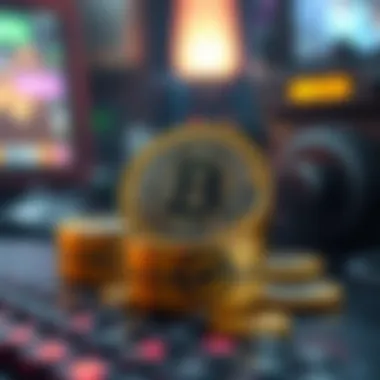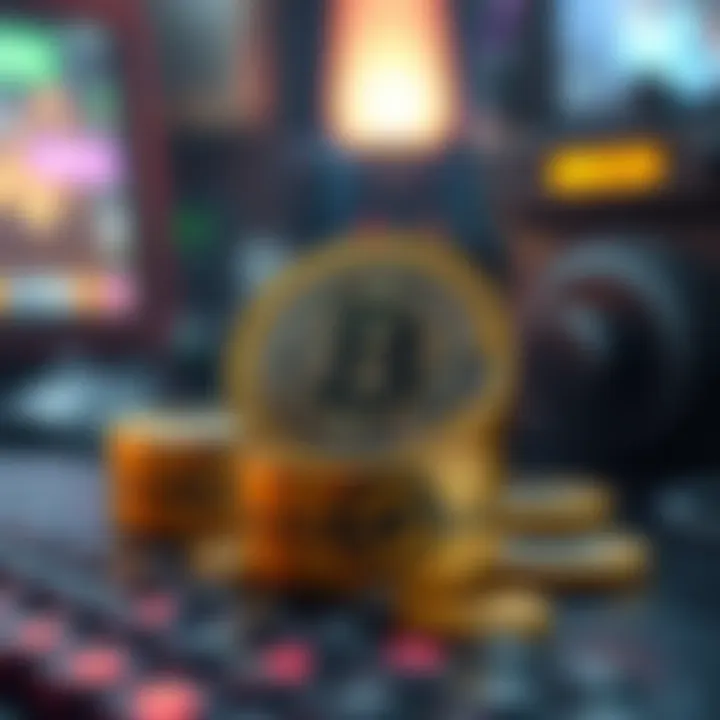Exploring Diverse Applications of NFTs Across Industries


Intro
In recent years, non-fungible tokens (NFTs) have surged into the limelight, captivating the imagination of both tech enthusiasts and investors alike. Initially recognized primarily for their role in digital art and collectibles, NFTs have rapidly expanded their foothold into numerous sectors. This article aims to peel back the layers, illuminating the diverse applications of NFTs and the revolutionary potential they wield across industries such as gaming, real estate, music, and intellectual property.
To navigate this vibrant and evolving landscape, it’s crucial to understand the underpinning technology that birthed NFTs. The heart of the matter lies in the blockchain—an innovative ledger system that records transactions in a decentralized fashion. This system not only secures the authenticity of each token but also enables their unique properties to be clearly defined.
As we proceed, we will dive into key use cases that highlight the practicality and implications of NFTs. Their impact on the digital economy holds the promise of redefining the concept of ownership, value, and engagement in the modern digital realm. Let’s embark on this insightful journey into NFT applications and their transformative influence.
Preface to NFTs
Non-fungible tokens, or NFTs, represent a seismic shift in how we perceive digital ownership. Unlike traditional tokens, like cryptocurrencies, which are interchangeable, NFTs stand as unique digital assets embedded in the blockchain, making them irreplaceable. This section sets the stage for a deep dive into the complex world of NFTs by examining their definitions and the underlying blockchain infrastructure that empowers these tokens.
Defining Non-Fungible Tokens
A non-fungible token embodies a distinct piece of digital content or data secured on a blockchain, granting proof of ownership and authenticity. This definition is crucial because it distinguishes NFTs from regular cryptocurrencies, which are fungible; that is, one Bitcoin is always equal to another Bitcoin.
NFTs can represent a myriad of digital items. These can range from digital art and music to ownership in virtual real estate. Imagine you own a one-of-a-kind digital artwork—it carries unique provenance and could potentially appreciate in value over time as demand increases. This uniqueness is on the core of why NFTs have garnered attention not just from collectors but also from investors and creators.
While their prominent role in art has attracted significant media coverage, it is vital to acknowledge their broader applications. For instance, in the gaming world, NFTs can serve as in-game items that players can trade or sell. Moreover, brands are exploring ways to incorporate NFTs into their marketing strategies to foster consumer engagement.
The Blockchain Framework
At the heart of NFTs lies blockchain technology, the decentralized ledger system that records all transactions transparently and securely. Bitcoin and Ethereum are the most recognized examples of blockchain, with Ethereum being the dominant platform for NFT creation.
In simple terms, blockchain is like a digital notebook, where every page, or block, holds a set of transactions that are linked together, forming a chronological chain. This design impedes tampering, as altering any single block would require overriding the entire chain, a near-impossible task given the extensive network of nodes validating transactions.
Moreover, smart contracts play a pivotal role in the utility of NFTs. These self-executing contracts allow conditions to be coded into the blockchain, automating various processes related to the buying, selling, and transferring of NFTs, thus streamlining the experience for users.
In summary, understanding NFTs entails grasping both their unique properties and the technology that underpins them. Both aspects are critical in evaluating their implications in the digital landscape. As we progress through this article, we will explore how NFTs extend beyond the realm of art into various other sectors.
Cultural Significance of NFTs
The cultural landscape is experiencing a seismic shift with the rise of non-fungible tokens, commonly known as NFTs. Unlike traditional assets, these digital tokens have found grounding in various cultural sectors, and their impact is being felt far and wide. Understanding their significance is essential, as it uncovers not only innovative avenues for expression but also new economic concepts shaping our digital economy. By exploring how NFTs intersect with culture, we unveil both what they offer and the implications for future creative endeavors.
Art and Digital Collectibles
Art has always been a mirror reflecting society, and NFTs provide a whole new canvas. Artists have begun to capitalize on this technology, allowing them to create, sell, and monetize digital artworks in ways previously thought unattainable.
Consider the success of platforms like OpenSea or Rarible. Here, artists can mint their pieces into unique tokens, giving them ownership rights that were hard to achieve in the physical world. For example, Beeple, a digital artist, sold a collage for a whopping $69 million. This transaction opened countless doors for artists struggling to get their work recognized amid an overwhelming sea of digital content.
- Unprecedented Ownership: NFT-based art establishes verifiable ownership, which cultivates authenticity in the digital arena.
- Community Engagement: These tokens allow artists to foster closer connections with their audience, leading to a more engaged fanbase.
- New Revenue Models: The traditional art market is dominated by galleries and auction houses, but NFTs create alternatives where creators can retain more profits.
Further, digital collectibles are not confined to art; the gaming world also teems with NFTs, featuring virtual items that can be owned, traded, or sold. Players can take pride in their unique gear or skins, resulting in profound player investment into the game universe.
The Role of Artists and Creators
Artists and content creators are at the forefront of this NFT revolution, redefining what it means to create in the digital space. Their role has evolved, leading to both opportunities and challenges, as they navigate this new terrain.
For one, artists leverage blockchain technology to take control of their creations. The smart contracts associated with NFTs not only ensure artists receive a cut from resales but also solidify their legacy. This is particularly significant in a culture where digital replication can dilute the perceived value of artworks.
- Empowerment of Creators: NFT platforms shift the balance of power from galleries to artists, allowing them better income streams and visibility.
- Diversified Income Channels: Beyond selling art, creators can offer exclusive content, membership access, or even behind-the-scenes experiences—all tokenized as NFTs.
- Challenges in Adoption: Despite the promise, many artists face hurdles in understanding the technology, leading to a potential digital divide that needs addressing.
Artists now have tools to engage directly with fans, creating a sense of community that was often missing in traditional art markets. But they must also remain vigilant. The NFT space can be rife with speculation and volatility, leaving some creators exposed to risks. As the digital landscape keeps evolving, artists will need to adapt continuously.


"NFTs are not simply a trend; they represent a fundamental shift in how we think about ownership and value in a digital medium." - Anonymous Artist
In summary, the cultural significance of NFTs extends beyond mere digital ownership. They represent a paradigm shift that intertwines creativity, technology, and commerce, suggesting a future where artists can thrive in an ever-evolving landscape.
NFTs in the Gaming World
The gaming industry is witnessing a radical transformation thanks to the infusion of non-fungible tokens (NFTs). This intricate intersection of gaming and blockchain technology paves the way for a myriad of applications that enhance player experience while also creating new revenue streams. NFTs offer players not just a way to interact with games, but also a form of ownership that was previously unheard of in the digital realm.
Play-to-Earn Models
One of the most thought-provoking innovations emerging from NFTs is the play-to-earn model. Unlike traditional games where players invest their time and, sometimes, money without any real return, play-to-earn games allow players to earn tangible rewards. This could be in the form of cryptocurrency or unique in-game assets that can be sold or traded on various platforms. For example, games like Axie Infinity have captured the imagination of many players, creating financial opportunities from gameplay that extend beyond the screen.
This model does not only encourage players to engage more deeply and competitively but also democratizes access to earnings in ways that traditional gaming does not. Players can potentially uplift their financial situations through skill and commitment, thus mixing gaming with elements of economic empowerment.
However, the model is not without its concerns. Issues surrounding how sustainable these earnings are, especially when they depend on fluctuating markets, merit serious discussion. If a player invests countless hours only to find the market plummeting, the disappointment could become substantial. The balance between fun and financial incentive thus is a crucial consideration for developers and players alike.
In-Game Asset Ownership
When you think about it, the concept of ownership in gaming has long been a curious case. Players have dedicated countless hours acquiring assets, unlocking characters, or crafting items, yet these achievements often belong wholly to the game publishers. NFTs change the narrative by bringing true ownership into play. In a blockchain environment, each asset owned by a player can be secured with proof of authenticity, making them verifiable and transferable.
Imagine earning a rare sword in a fantasy game. With NFTs, not only can you wield it within the game, but you may also sell, trade, or display it in a digital gallery — all while having the assurance that your ownership is recognized. Moreover, this opens the door for players to customize their gaming experiences fully. Custom items can be purchased or even created by users and traded among the community.
However, potential legal issues can arise, particularly when discussing ownership rights over assets created by players within a game. Clarity on the legal standing of in-game items remains a key point for developers and gamers to navigate. Players may find themselves in disputes if game developers try to exert control over trade or ownership of assets they believe they rightfully own.
Real Estate Applications of NFTs
The intersection of real estate and non-fungible tokens (NFTs) is a burgeoning field, showcasing how technology can streamline and modernize property ownership. The concept of NFTs, which are unique digital assets verified on a blockchain, has plenty of implications for real estate transactions and management processes. This section delves into the significance of NFTs in real estate, particularly focusing on ownership verification and fractional ownership opportunities.
Ownership Verification and Sales
One of the core advantages of integrating NFTs within real estate transactions lies in ownership verification. Traditional property deeds can be cumbersome and riddled with issues, such as fraud or disputes over rightful ownership. By creating an NFT for a piece of real estate, ownership can be securely recorded on a blockchain, offering an immutable record that's accesible to all parties involved.
- Transparency: Both buyers and sellers can effortlessly verify ownership history, which leads to a reduction in potential conflicts over property titles.
- Efficiency: Processes that usually take days or weeks, like title searches, can be abbreviated significantly.
- Cost-Effective: With fewer intermediaries involved (like lawyers and title companies), buyers may experience reduced transaction costs.
Transferring ownership is equally straightforward. The NFT can simply be transferred from one wallet to another, effectively changing ownership without the need for tedious paperwork and bureaucratic delays. Once a buyer holds the NFT, they own that property, plain and simple. This concept not only simplifies sales but also makes it possible to conduct real estate transactions across borders with ease.
"The use of NFTs disrupts traditional real estate models by streamlining processes and verifying ownership in a way that's nearly impossible to tamper with."
Fractional Ownership Opportunities
Another intriguing application of NFTs in real estate is fractional ownership. Traditionally, property investments require substantial capital, making it difficult for individual investors to participate. However, NFTs pave the way for fractionalized property ownership, enabling multiple investors to own a percentage of a property.
- Accessibility: With NFTs, an individual can purchase a fraction of a luxury apartment or commercial space at a lower entry point, breaking down financial barriers.
- Diverse Investment Opportunities: Investors are now able to diversify portfolios by owning parts of various properties, rather than being tied to a single real estate asset.
- Liquidity: Selling a fraction of a property becomes easier when it’s tokenized. An investor can sell their NFT—representing their share—on an open marketplace, enhancing liquidity in the traditionally illiquid real estate market.
NFTs in Entertainment and Music
In the realm of entertainment and music, NFTs are emerging as a revolutionary force, transforming traditional structures and opening new avenues for artists and fans alike. This trend is significant not just because of the financial aspects, but also due to the ways it influences how music is created, distributed, and consumed. As artists explore this technology, it reshapes relationships within the music industry and enhances community engagement, showcasing NFTs' potential to redefine value in this domain.
Novel Revenue Streams for Musicians
Musicians have always faced challenges when it comes to generating revenue from their art. With traditional models often favoring record labels and streaming platforms, many artists find it difficult to earn a living solely from their music. NFTs introduce a fresh approach to monetization. Through tokenization, artists can sell unique pieces of music, such as singles, albums, and even exclusive merchandise, directly to fans. This shift enables artists to retain a larger share of revenue while creating a more personalized connection with their audience.
Consider an artist who launches a limited edition album as an NFT. Fans can purchase this token, granting them not only access to the music but also perks like behind-the-scenes content, VIP concert tickets, or even a chance to participate in a song creation session. This model not only boosts direct sales but also fosters community around the artist's work. Artists can tailor what they offer, creating varied experiences for fans.


Moreover, NFTs can be programmed to allow artists to earn royalties on future sales. If a fan chooses to resell the NFT, a percentage of that sale could go back to the artist. This mechanism ensures that musicians can benefit continually from their creations, establishing a sustainable income stream in an industry often fraught with uncertainty.
Fan Engagement and Community Building
The role of NFTs goes beyond mere financial transactions; they have the power to foster deeper connections between artists and their communities. In an age where fans are clamoring for authenticity, NFTs provide a means for artists to create exclusive content that resonates. By offering tokens that grant access to limited events or personalized experiences, artists can turn casual listeners into committed advocates.
For example, a band could release an NFT that serves as an all-access pass for their fans. Holders of this NFT might gain entry to private rehearsals, meet-and-greet sessions, or even online Q&A events, reinforcing a sense of belonging and loyalty. This depth of interaction enriches the fan experience and transforms the artist-fan dynamic into a more collaborative relationship.
"NFTs allow artists to deepen their connection with fans, turning them from mere listeners to active participants in the creative journey."
In addition, the community aspect is enhanced through social platforms that support NFT trading. Fans can discuss, share, and trade their digital assets, creating a vibrant marketplace and a community grounded in shared passion. Artists can tap into this by hosting events or discussions around their NFT drops, encouraging engagement and boosting visibility.
Intellectual Property Rights and NFTs
The intersection of intellectual property rights and non-fungible tokens (NFTs) is a realm that deserves delicate consideration. As digital assets proliferate in various sectors, understanding how these rights operate within the NFT framework is essential for creators and consumers alike. Intellectual property encompasses the creations of the mind, which include inventions, artistic works, and symbols. In the rapidly evolving NFT landscape, the dynamics of these rights present both opportunities and hurdles for artists, brands, and NFT buyers.
NFTs enable artists to tokenize their work, essentially assigning a unique digital certificate of ownership. Yet, the clear demarcation of copyrights when minting an NFT often presents challenges. Creators must ask, “What rights am I transferring to the buyer?” This brings us to the nexus of copyright and ownership issues, where the rights associated with an NFT can be murky and complicated.
Copyright and Ownership Issues
Ownership of an NFT does not automatically confer copyright to the underlying work. This is a common misconception among buyers, and often leads to disputes. When an NFT is sold, what typically gets transferred is the right to the NFTs copy and its associated digital certificate of ownership, rather than the copyright itself.
- Creator's Rights: Artists may retain their moral rights, which include attribution and the right to prevent derogatory treatment of their work. Notably, this can complicate resale scenarios, where the new owner might not fully grasp the creator’s rights.
- Resale and Royalties: Many platforms now allow creators to earn royalties on secondary sales of their NFTs. This means when an NFT is resold, a percentage of the sale can revert back to the original artist, forming a sustainable income model. However, it's crucial for creators to set these terms clearly prior to the initial sale.
"If artists don’t clarify what rights are being transferred, they risk losing control over their work, which could diminish its value and lead to complicated legal disputes in the future."
In navigating these issues, it’s important for buyers to conduct due diligence, ensuring clarity on what rights they acquire with each NFT purchase.
Licensing and NFT Transfers
The licensing of NFTs introduces another layer of complexity within the intellectual property framework. Licensing agreements can dictate how an NFT can be used, forbidding or permitting certain actions. This aspect is crucial for both creators and buyers to negotiate and understand clearly.
- Smart Contracts for Licensing: Smart contracts, the backbone of most NFTs, can automate the licensing process. By embedding licensing terms directly into the NFT's smart contract, both parties can ensure that rights are maintained according to pre-agreed conditions. This can cover aspects like usage rights, display rights, and more.
- Transfer of Rights: When an NFT is transferred, the original rights may not automatically follow unless explicitly stated in a licensing agreement. Buyers must be aware of what they can or can't do with their digital assets. For instance, can they display it in a virtual gallery or create merchandise using the artwork? The clarity of these rights can define the value and utility of an NFT significantly.
With each NFT transaction, the importance of transparent and comprehensive licensing agreements cannot be overstated. Both sides—the creator and the buyer—must engage in clear communication regarding the expectations and limitations associated with the digital asset.
In essence, the realm of intellectual property rights in relation to NFTs showcases the importance of understanding ownership nuances and licensing dynamics, pivotal for asserting value and protecting creators' interests in this digitized marketplace.
Potential Risks and Challenges
As the landscape of non-fungible tokens (NFTs) continues to evolve, understanding the associated risks and challenges becomes paramount for anyone engaged with this technology. It’s not just the opportunities that need to be addressed but also the potential pitfalls that can affect investors, creators, and users alike. The realm of NFTs showcases great innovation, yet these advancements come with significant considerations that warrant a thorough examination.
Market Volatility
One of the biggest concerns surrounding NFTs is market volatility. The prices of NFTs can swing dramatically in short spans, often determined by consumer interest and speculative activities rather than intrinsic value. For example, the meteoric rise in the value of certain digital artworks has been met with equally sudden drops, leaving some investors high and dry. This unpredictability creates a risky environment where investments can turn sour overnight.
It’s vital for potential buyers to approach NFTs with caution. Here are a few factors contributing to this volatility:
- Hype Cycles: Influencer endorsements and viral marketing can artificially inflate prices.
- Scarcity: Limited editions naturally create a sense of urgency, leading to inflated valuations that may not be sustainable.
- Lack of Regulation: Unlike more traditional financial markets, NFTs operate in a largely unregulated space, making it hard to predict market movements.
Understanding these aspects can help individuals make informed decisions, mitigating the risks associated with sudden market changes.
Environmental Concerns


The environmental implications of NFTs also pose a serious concern. Most NFTs are minted on blockchains that utilize proof-of-work protocols, such as Ethereum. This process is energy-intensive and contributes to a significant carbon footprint. Critics argue that the popularization of NFTs could exacerbate climate change, as evidenced by the ever-increasing energy consumption of blockchain networks.
Here’s a breakdown of the environmental challenges linked to NFTs:
- Energy Consumption: Transactions can require vast amounts of computational power.
- Carbon Footprint: The emissions contributed by mining activities can be substantial.
Crafting a strategy to mitigate these environmental effects can greatly improve the sustainability of the NFT space. Some solutions include:
- Transitioning to proof-of-stake mechanisms which consume less energy.
- Supporting green projects and initiatives that seek to offset blockchain emissions.
Legal and Regulatory Landscape
Navigating the legal and regulatory framework surrounding NFTs can be quite daunting. As a relatively new domain, laws relating to digital ownership, copyright, and consumer protection are still catching up with technological advancements. Challenges arise in multiple domains, including:
- Copyright Issues: Who holds the rights when an NFT is sold? Is it the creator or the buyer? These questions often lead to legal disputes that can undermine the integrity of the NFT market.
- Fraud and Scams: In a space where anonymity is a feature, scams abound. Users need to be wary of counterfeit NFTs and fraudulent platforms that compromise the security of their investments.
Moreover, regulatory bodies around the globe are still formulating guidelines to govern NFT transactions. Staying informed about these changes is crucial for anyone involved in the NFT market. Regularly following resources such as
Wikipedia - NFTs or industry-focused news outlets can provide clarity on upcoming regulations.
“Navigating the volatile and complex landscape of NFTs requires a thorough understanding of both their rewards and risks.”
In sum, while NFTs provide cutting-edge opportunities across various sectors, the market is rife with volatility, environmental concerns, and legal challenges that warrant thoughtful appraisal. Engaging with NFTs must be a cautious endeavor, fueling deeper scrutiny in its implementation and usage.
Future Outlook for NFTs
The future of non-fungible tokens (NFTs) holds vast potential that reaches far beyond their current popular applications in digital art and collectibles. As technology continues to evolve, the understanding and utilization of NFTs are likely to expand across various sectors, creating new opportunities and challenges. This section will explore what the future could look like, along with the benefits and considerations that come with it.
Emerging Trends in Technology
Technological advancements are often the backbone of any innovation, and NFTs are no exception.
- Increased Interoperability: Future developments might lead to better interoperability between different blockchain platforms. This means that users can easily transfer their NFTs across various ecosystems, broadening their usefulness and appeal.
- Smart Contracts Evolution: New features in smart contracts could unlock additional functionalities for NFTs. For instance, royalties could become automatic every time an NFT is resold, ensuring creators continue to benefit from their initial work as it changes hands.
- Enhanced User Experience: User experience will likely become more intuitive. Innovations in wallet technology, for example, may allow users to manage their NFTs seamlessly without needing a deep understanding of blockchain intricacies.
The technological landscape for NFTs is set to undergo remarkable transformations, offering enhanced features and greater accessibility for users and creators alike.
NFTs and the Metaverse
The metaverse, an evolving collective virtual shared space created by the convergence of virtually enhanced physical reality and physically persistent virtual reality, opens a new frontier for NFTs. In the metaverse, NFTs can represent not just digital art or collectibles but can also encapsulate unique virtual real estate, clothing, and even avatars that individuals can own and trade.
- Virtual Ownership: Just as physical land can be bought and sold, so too can virtual plots within the metaverse. The ownership is verifiable through NFTs, making property rights clear and catalogued.
- Integration of NFTs: Social and gaming platforms within the metaverse could integrate NFTs for distinguishing avatars or granting access to exclusive digital environments.
- Economic Models: As more users enter the metaverse, new economic models could emerge around NFTs promoting a true digital economy, where users can leverage their virtual assets for real-world value.
With these developments on the horizon, stakeholders—from investors to creatives—must keep an eye on how the convergence of NFTs and the metaverse will reshape our understanding of ownership and value in the digital world.
Finale
As we wrap up the exploration of non-fungible tokens (NFTs), it's crucial to reflect on their ever-growing significance in the digital landscape. This conclusion synthesizes the insights presented throughout the article, emphasizing the multifaceted nature of NFTs across various industries. They have transitioned from mere digital collectibles to a potent tool for business innovation and economic development.
The implications of NFTs are vast and myriad. Their use in sectors like gaming, real estate, and music showcases how digital ownership can redefine value creation. With their roots in the blockchain framework, NFTs provide not just proof of ownership but also enable creators to monetize their work in unprecedented ways. This monetization creates a continual revenue stream, benefiting not only the original creators but also potentially their fans and community members.
Summary of Key Insights
- Diverse Applications: From the art world to gaming, NFTs serve multiple purposes, altering business models and consumer interactions.
- Economic Impact: NFTs allow for new revenue avenues for artists and developers, fostering economic growth in various sectors.
- Ownership and Authenticity: On the blockchain, NFTs offer a definitive proof of ownership that ensures authenticity, which is significant in decreasing fraud.
- Community and Engagement: They enhance fan engagement, allowing communities to build around artists and projects, which fosters loyalty and direct support.
The journey of NFTs is just beginning, presenting both challenges and opportunities. Investors and enthusiasts alike should watch closely as this landscape evolves, understanding that the apparent volatility comes with potential for high rewards.
Final Thoughts on NFTs
Adopting NFTs also entails awareness of the associated environmental and legal considerations. The regulatory landscape is still taking shape, and unforeseen challenges may arise in the coming years. Thus, staying informed and engaged with ongoing developments will be key for anyone looking to navigate this nascent space successfully.
In sum, NFTs represent a transformative force. They are not a fleeting trend but signify an evolution in how we interact with digital assets. Their future holds promise, and it is within our grasp to shape it into something impactful and meaningful.
"The NFTs landscape will continue to unfold, revealing surprises, challenges, and advancements that will ultimately redefine engagement in the digital economy." \n For further insights on NFTs, you may explore resources like Wikipedia, Britannica, and engaging discussions on Reddit where enthusiasts share insights and experiences.



